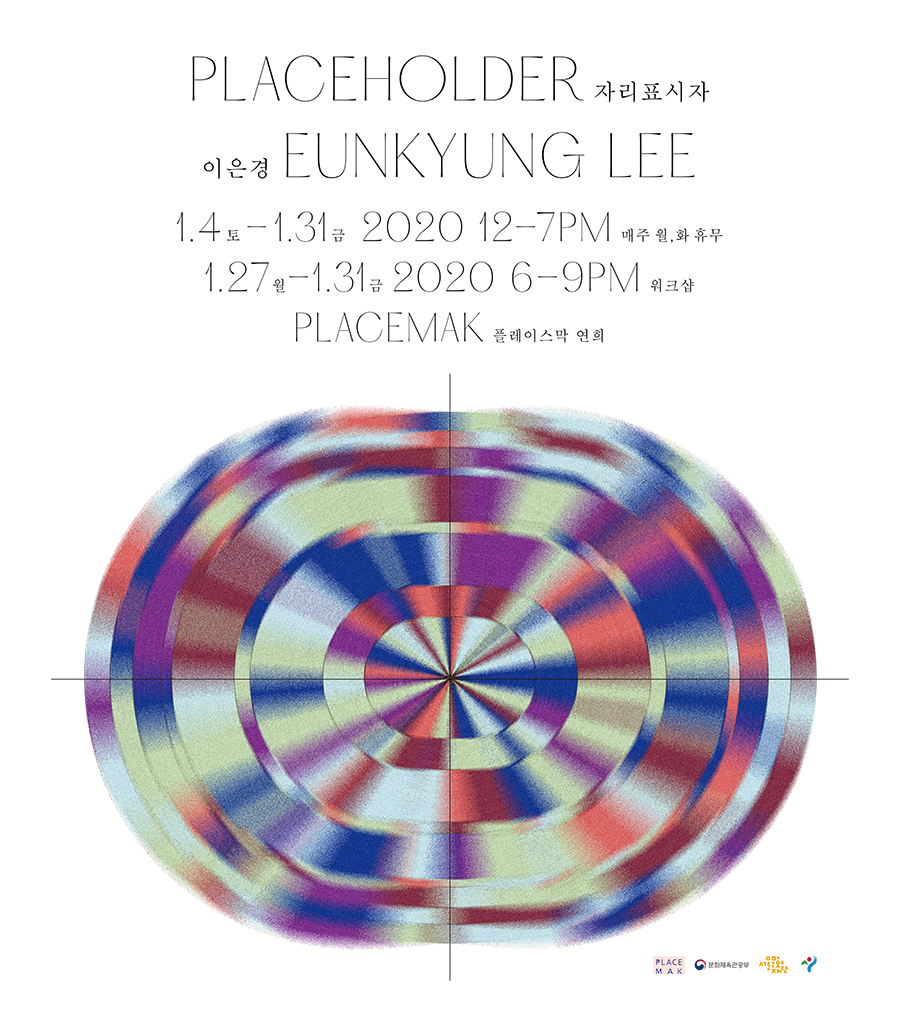이미지에서 질료로: 이은경의 메타 회화에 대한 소고
사물들의 내면에서 일어나는 것이 무엇인지를 알고자 하면서도 당신은 그것들의 겉모양을 주시하는 데 만족한다. 당신은 골수를 맛보고자 하면서도 껍데기에 매달려 있다.
“하나의 그림은 전장의 말이나 누드 여인이나 어떤 일화이기 이전에, 본질적으로 일정한 질서를 따라 조합된 색채로 뒤덮인 편평한 표면이라는 사실을 기억하는 것이 좋다”는 모리스 드니의 유명한 말처럼, 회화의 역사가 ‘무엇을 그렸는가’에서 ‘어떻게 그렸느냐’로 이행한 경위는 비교적 잘 알려져 있다. 지금도 계속되는 재현 대 비재현의 오랜 엎치락뒤치락은 그려진 내용을 중시하느냐 이를 표현하는 형식적 요소를 중시하느냐를 둘러싼 입장의 차이이자 ‘회화란 무엇인가’라는 정의를 둘러싼 화가들의 치열한 매체 탐구일 것이다. 그런데 주제를 중시하든 선, 색, 면, 리듬 같은 구성을 강조하든 간에 간과되는 지점이 하나 있다. 그림은 일화일 수도 있고 색채 조합의 표면일 수도 있지만, 그 이전에 지지대 위에 얹어진 안료라는 사실이다. 심지어 예술에서의 순수란 각 매체의 한계를 기꺼이 받아들이는 것이라 주장하며, 회화의 고유성은 그림 면의 침해할 수 없는 평면성, 유채 물감의 가촉성, 지지대의 재질에 있다는 극단적인 유물론을 주장한 클레멘트 그린버그조차 추상 색면 회화의 평면성 이전에 이를 만들어내는 물적 토대인 재료에 주목하지는 않았다.
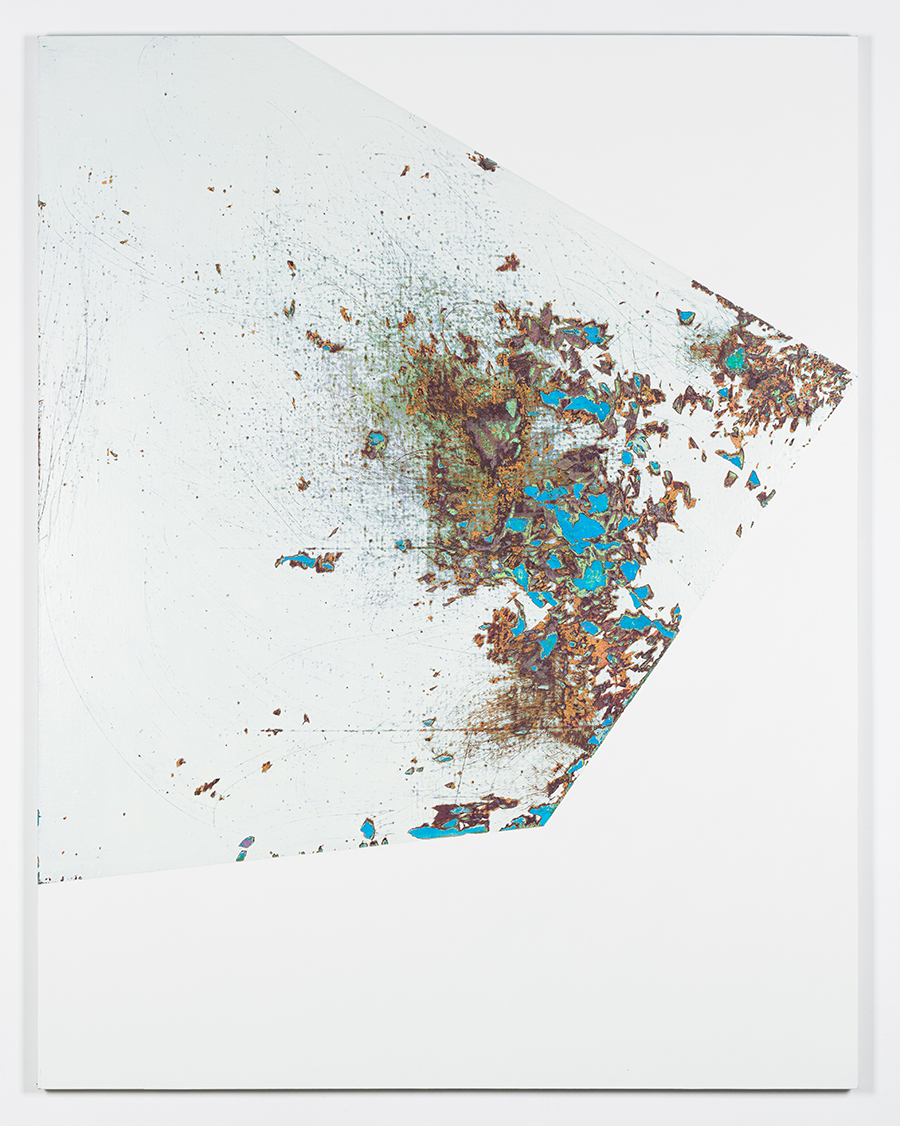
반_A half, 140x180cm, 아교, 린시드오일, 석고, 안료, 난황, 2018
메타 회화로서의 템페라
2008년부터 현재까지 지속되고 있는 이은경의 템페라화는 실질적인 제작에서는 언제나 중요했으나 최근의 회화사에서 간과되어 온 질료를 매체 탐구의 중심으로 부각시키는 실험이다. 이미지 이전에 존재하는 물질들, 그중에서도 색을 만들어내는 채색 재료(안료와 미디엄)에 주목하는 그의 그림은 회화를 구성하는 가장 근원적인 입자로 돌아가 회화의 근원을 탐구하는 메타 회화다. 이를 위해 작가는 사용이 불편하고 호흡이 느려 현대 회화의 재료로는 거의 사용되지 않는 템페라 기법을 동시대로 다시 호명한다. 템페라는 가루로 된 안료를 달걀노른자에 개어 만든 물감을 사용하는 화법을 뜻한다. 달걀노른자가 주된 미디엄이므로 금방 상하거나 변할 수 있어 오래 보관할 수 없다. 수요도 적고 보관도 어려우므로 기성품으로 구입할 수 있는 색상의 범위가 제한적이라 원하는 색을 내려면 그때그때 안료를 개어 물감을 손수 만들어야 한다. 템페라는 유연성이 없어서 부드럽게 색칠되지 않고 유화처럼 두껍게 마띠에르를 내는 것이 불가능하므로 딱딱한 느낌이 있지만, 수채화보다는 강력한 색감을 내므로 16세기 이후 유채 캔버스화가 주류가 될 때까지 명맥을 유지하며 활용되었다.
이은경이 템페라를 택한 것은 아마도 “안료의 원래 색상과 아주 비슷한 색으로 마르기 때문에 작품의 최종 색을 쉽게 예측할 수 있다는 점 때문일 것이다. 작업의 목적이 “색이 온전히 부피와 질감을 가진 조각적 물질로서 만들어내는 회화적 사건을 실험하는 것이기에, 자연물에서 유래한 안료의 색감을 최대한 가깝게 느낄 수 있는 기법이 개념상 부합한다. 실제로 시험 삼아 작가의 작업실에서 라피스라줄리(lapis lazuli, 광물), 코치닐 레이크(Cochineal lake, 곤충), 계관석(Realgar, 광물) 등의 안료 가루로 템페라 물감을 만들어 본 결과, 광물의 경우 입자성이 강해 물감을 개고 칠할 때 알갱이가 그대로 느껴졌으며 동물성이나 식물성 안료의 경우 상대적으로 입자가 고와서 발색이 훨씬 고르고 진하게 칠해졌다. 물감을 만들고 캔버스 위에 물감을 올리며 “나이프와 붓끝에 걸리는 알갱이들의 질감을 온전히 흡수해 질료에서 전달되는 총체적 감각을 드러내는 것이 이은경이 의도하는 회화적 사건이라면, 그 수단으로서 템페라는 상당히 좋은 메타 회화의 재료인 셈이다.
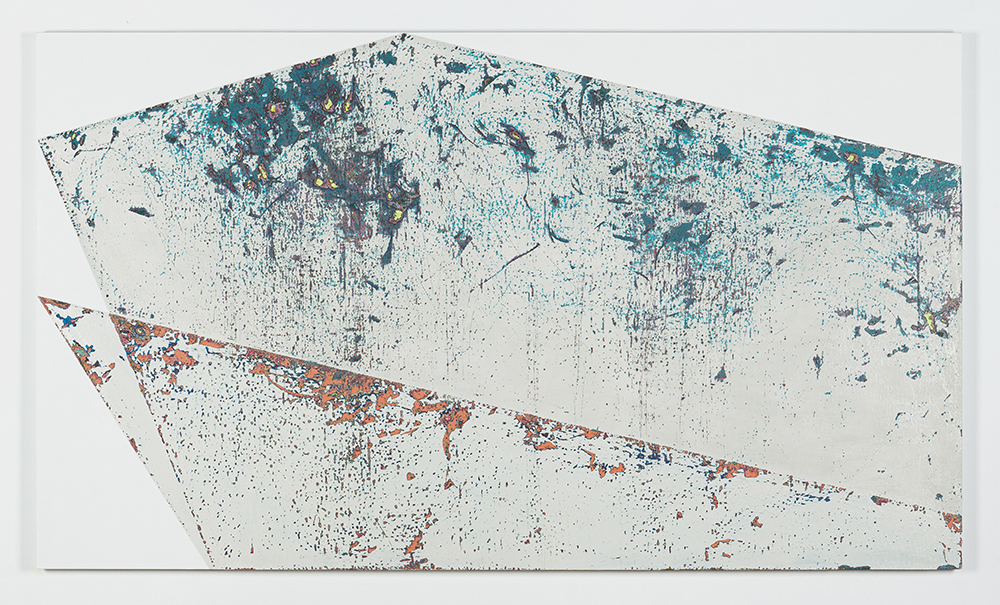
새벽_Dawn, 190x110cm, 아교, 린시드오일, 석고, 안료, 난황, 2019
재료와 이미지
화가라면 누구나 알고 있듯이 이미지의 속성 및 화법은 재료에 의존한다. 빨리 마르는 아크릴화로 그릴 때 적합한 소재 혹은 붓질과 천천히 마르는 유화로 그릴 때 맞는 소재 혹은 기법은 극명히 다르다. 마찬가지로 템페라로 작업하는 이은경의 그림도 재료의 물성이 작업의 개념이나 이미지의 성격에 개입한다. 이번 전시 이전의 템페라 작업인 <Collected Samples>(2010-2011, 2013) 연작은 전단지나 잡지, 거리 등 주변에서 수집한 일상의 이미지들을 채취해 표본 샘플처럼 동그란 캔버스 위에 수집한 작업이다. 포장지나 상표 등 실제 사물의 표면을 떠낸 것이기 때문에 이미지는 구상이며 부분적이나마 형태를 인지할 수 있다. 이후 작가는 캔버스를 사포로 갈아내거나 바닥에 놓인 캔버스를 발로 미고 다니는 퍼포먼스를 통해 작품의 표면에 흠집을 낸다. 마치 그래피티나 스케이트보드 표면처럼 균열과 박탈이 발생한 캔버스는 탄성이 없고 내구성이 약해서 충격을 가할 경우 잘 깨지는 템페라의 물성에서 비롯된 것이다. 이는 한 필자의 해석처럼 재료의 물리적 유약함이 재현 구조에 균열을 일으켜 환영의 유약함을 증명한다.
이후 작업은 구상의 비중이 줄고 회화 표면 및 이미지의 본성에 집중하는 쪽으로 진행된다. 그룹전 《PHARMAKON》(디스위켄드룸, 2018)에서 선보인 <제 자리를 벗어난 것들>(2018) 연작은 사포질을 통해 층층이 쌓인 물감층을 드러내는 기법이 본격화된 작업이다. 읽힐 수 있는 형상과 읽히지 않는 추상이 공존하며 동일한 재료가 만들어내는 상반된 두 차원(무언가를 대변하는 이미지와 재료 그 자체의 물성을 증거하는 이미지)이 이접된다. 여기서 구현되는 하나의 차원에서 또 다른 차원으로 넘어가는 이행의 상태는 실제로 구상에서 추상으로 넘어가는 작업의 변천과 맞물려 있기도 하다.
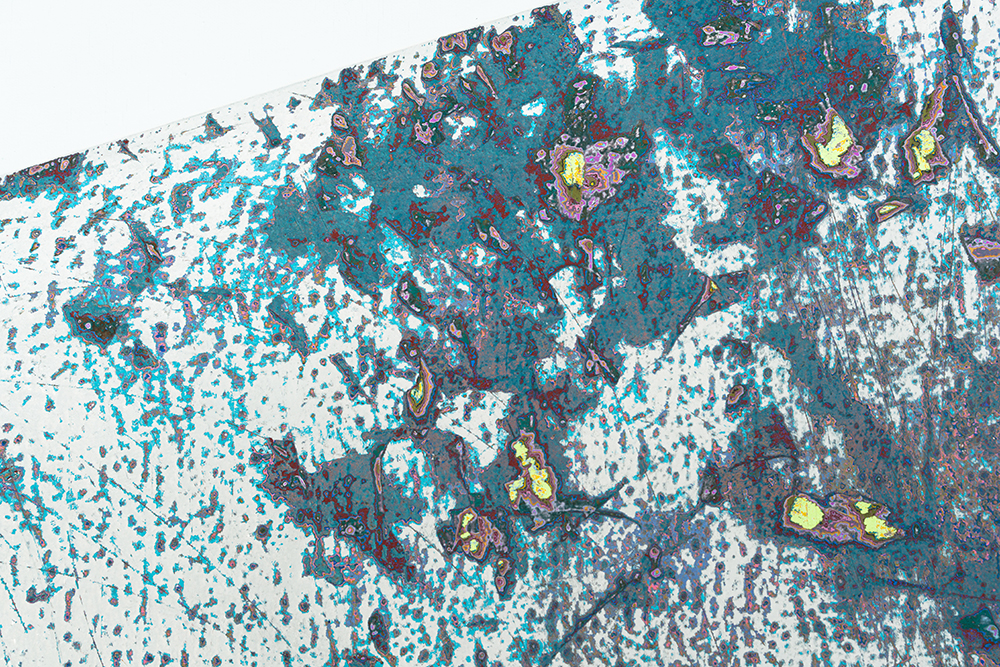
새벽 / 디테일컷_Dawn, 190x110cm, 아교, 린시드오일, 석고, 안료, 난황, 2019
《Placeholder》(플레이스막, 2020)에서 선보이는 <Eclipse> 연작 6점은 완전히 추상으로 이행한 작업의 현재를 보여준다. 하나의 색감을 내는데 3-4겹의 물감층을 올리고 최소 30개의 색을 쌓아 올리므로 각 작업은 수십 층의 템페라 색층을 갖게 된다. 이후 작가는 세 가지 다른 결의 사포를 동원해 색의 지층을 긁어낸다. 사포질은 “앞으로 혹은 위로 솟아올랐던 표면”을 “뒤로 혹은 안으로” 파고 들어가는 역전의 행위다. 작업은 형태의 배치, 사포질의 강도와 방향, 물감을 쌓는 순서 및 방식, 긁어내진 면적과 깊이에 따라 추상적 형태의 변이를 보여준다. 일례로, <반>(2018)에서 사포질로 노출된 표면의 면적과 방향은 다각형의 모서리 끝으로 집중되는데, 이렇듯 형태와 노출된 색면이 조응하는 현상은 과거작에서는 나타나지 않던 특징이다. 추상적 감각을 물리적 형태로 전환하는 방식은 다른 작업에서도 비슷하게 나타난다. 무더위에도 무럭무럭 자라는 바질의 생장 에너지를 무한대 기호로 표현한 <바질>(2018)에서도, 노출된 물감층의 면적과 깊이는 방울 형상이 맞닿은 첨점(에너지의 응축 지점)에 가까워질수록 넓고 깊어진다. 한편, 형태는 공유하되 갈기의 방식에 따라 다른 형태의 추상 이미지가 도출되는 실험도 행해진다. <데자뷰>(2019)는 나란히 반복된 동일한 형태를 다르게 갈아내 같고도 다르고 다르고도 같은 차이와 반복을 형상화했고, 세트 형식의 두폭화 <반>은 붙이면 연결되고 떼어내면 별개인 캔버스의 형태적 특징을 분리 이전에는 동일하게 물감층을 쌓고 분리 이후에는 사포질을 달리해 색면의 양상 및 색깔이 달라지는 이미지의 질적 차이로 연결시킨다.
<Eclipse> 연작은 일반적으로 유화에서 중시되는 붓질의 기교나 색 또는 형상의 변환을 최소화한다. 여기서 붓은 그저 균질하게 하나의 색면을 바르는 도구일 뿐이며, 화가의 자의적 해석이나 개입은 억제된다. 화가의 표현을 자제하고 단순히 색면을 계속 쌓아 올리는 기법은 템페라의 물성을 수용한 결과다. 유화에 비해 빨리 마르고 비교적 단단한 도막을 형성하는 템페라의 특성은 물감층을 쌓고 갈아내기에 적합하다. 과거 르네상스 시기 템페라에서 유채로 이동하게 된 것도, 응고 과정을 적절히 통제할 경우 자연스러운 명암효과와 질감묘사를 낼 수 있는 글레이징(glazing)이나 임파스토(impasto) 기법을 유채에서 훨씬 쉽게 얻을 수 있었기 때문이다. 화려한 붓질의 기교를 통해 화가의 재능을 드러내기 쉬웠던 유채가 이동이 편리해 보관이 쉬웠던 캔버스 재료와 결합되면서 회화사는 ‘무엇으로 그렸느냐’ 혹은 ‘무엇을 그렸느냐’에서 ‘어떻게 그렸느냐’의 문제로 완연히 이행하게 된다. 그런 점에서 이미지의 환영 및 붓질의 비중을 최소화한 <Eclipse> 연작은 기법 혹은 개념에 쏠려있던 회화의 눈을 재료로 되돌리는 고고학적 발굴이라 볼 수 있을 것이다.
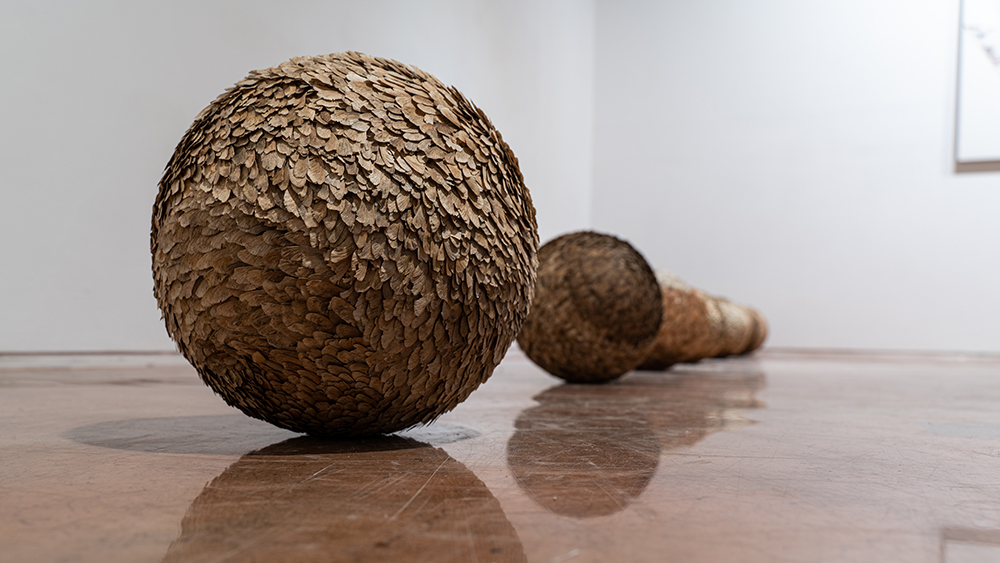
아르마딜로_Armadilo, 가변크기(개별 24x24x24cm), 단풍나무 씨앗, 스티로폼구, 2017-2019
질료적 상상력과 내밀한 시간
모든 물감을 직접 만드는 템페라는 결국 색을 내는 안료 탐구에 다름 아니다. 오랜 시간 템페라를 다루며 작가는 자연에서 나온 여러 안료들을 연구하다 안료의 역사와 특징, 원재료 및 화학성분을 정리한 안료 연대표를 만들었다. 검정색 안료 하나만 해도 포도 씨앗, 그을음, 오징어 먹물, 화산 유리, 광물 등 동물, 식물, 광물을 망라하는 폭을 지닌다. 이러한 안료들은 ‘검정’이라는 한가지 범주로 환원되는 기성 물감에서 발현될 수 없는 미묘한 색조 차이와 질감 차이를 지닌다. 포도 씨앗을 태운 숯에서 나온 검정은 푸른 빛을 띄는 검은색이고, 오징어 먹물에서 나온 검정은 약간의 비릿함을 지닌 투명한 검정색이다. 작가는 자연이 선사한 색채를 보고 만지고 느끼며 자연의 시간을 명상하고 질료가 품고 있는 무한한 가능성에 놀란다. “나는 매일 신선한 유기물로 물감을 만들고, 만들어진 색을 천천히 쌓아가며, 그것을 긁어내고 갈아내는 과정을 반복해 현재를 재구성한다. 이 과정을 통해 끊임없이 자연과 내면의 시간을 회화적 언어로 교차시키고, 마음속에서 일어나는 현상을 색으로 기록하며, 그 의미를 수차례 되짚는 성찰의 행위를 거듭한다.
마치 종교적 수행 행위를 연상시키는 작가의 말은 정확히 볼프강 라이프(Wolfgang Laib)의 태도를 떠올리게 한다. 민들레 꽃가루, 우유, 쌀, 밀랍 등 어떤 인공물도 첨가되지 않은 자연 그대로의 재료를 사용하는 라이프의 작업은 재료의 채취부터 작업의 제작 과정까지 모두 제의의 과정이다. 꼬박 6개월을 소모해 겨우 네 병에서 여섯 병 정도의 꽃가루를 수확하고, 이렇게 얻은 귀한 재료를 채로 쳐서 갤러리 바닥에 아주 얇게 뿌리는 과정은 자신을 낮추고 자연에 순종하는 경건한 제의 의식이다. 작가의 오랜 노동과 수행의 결과물이자 다음 세대를 가능케 해주는 생명의 씨앗인 꽃가루를 통해 관객들은 시간을 초월한 자연의 순리와 구체적인 사물 안에 내재된 영적 존재를 느끼게 된다. 이은경의 템페라 작업에서도 작가는 자연의 재료가 만들어내는 풍부하고도 섬세한 색감들을 경험하며 “자연의 시간과 내면의 사건이 얽히는” 명상의 시간을 갖게 된다. 유사 이래 그림과 함께해 왔던 안료의 고고학적 시간이 물감의 발색을 느끼는 작가의 현재의 시간과 만나고, 다양한 색면을 바르고 말리고 또다시 쌓는 느리고도 정성스러운 지속의 시간성이 결과물로서의 회화를 한눈에 일별하는 관객의 현전의 시간성과 교차한다. 이렇게 과거와 현재, 미래가 비선형적으로 얽히는 시간성은 벤야민이 말하는 창조적 도약으로서의 변증법적 시간이요 베르그손이 이야기하는 우주적 지속의 순간이다.
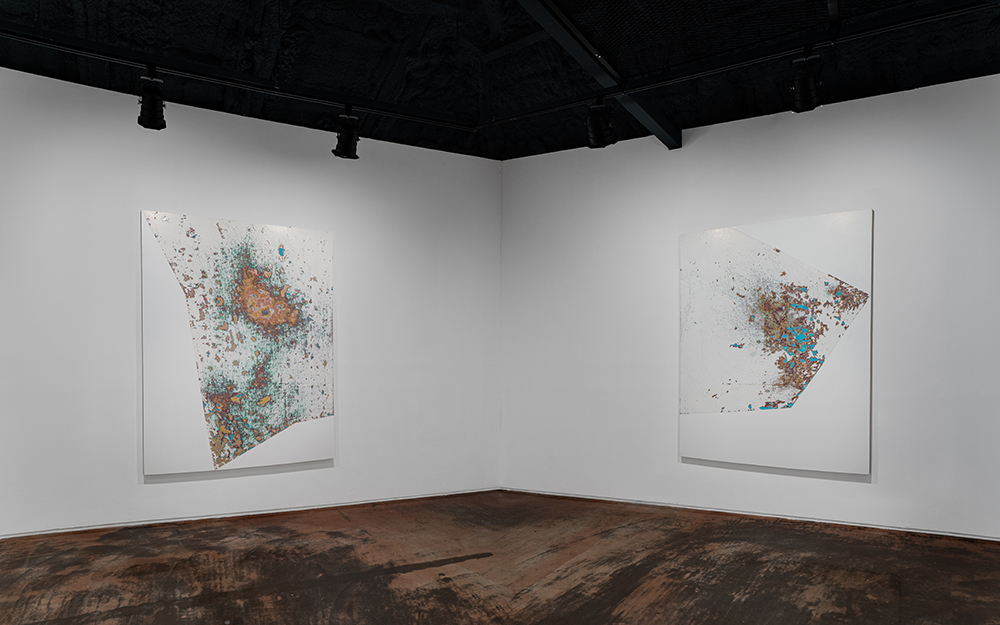
설치전경
형상을 넘어, 이미지를 넘어, 색을 만들어내는 질료의 시간으로 들어가는 이은경의 태도는 물질의 표면을 넘어 물질적 이미지들 속에 숨겨져 있는 심연을 꿈꾸는 바슐라르의 질료적 상상력에 다름 아니다. “일하는 사람은 ‘사물들의 표면에’ 머무르지 않는다. 그는 내밀성에 대해, 철학자만큼이나 ‘심오’하게, 내면적 특성들에 대해 꿈꾼다. 그는 천천히 목질이 흡수할 수 있는 최대의 밀랍을, 그러나 지나치지 않게 목재 위에 붓는다. 호두의 배아에서 사물의 미세함에 갇혀있는 우주적 신비를 본 스트린드베리(Strindberg), 피레네 산중 여울의 하얗게 부서지는 물살에서 물의 이면을 보는 프랑시스 잠(Francis Jammes), 우유의 백색 아래 숨겨진 은밀한 거무레함을 느끼는 오디베르티(Audiberti)는 모두 사물들의 한가운데로 나아가 질료의 가장 세세한 내밀성을 발견한 자들이다. 물의 움직임을 관찰하고 여기서 독특한 긴장감의 운동성을 감지해 이를 형상화한(<물>(2018)) 이은경 역시 사물의 표면에 머물지 않고 상상을 통해 그 중핵으로 들어갔으니 질료를 꿈꾸는 자라고 할 수 있을 것이다.
여기서 한 가지 제안을 하고 싶다. 이은경의 작업은 안료에 대한 탐구에서 출발해 즉각적인 이미지와 결별하고 보다 순수한 감각으로 이어지는 추상으로 진행되었다. 추상 이미지의 기원이 되는 관찰 대상인 사물의 내밀성과 이를 시각적으로 형상화하는 재료인 안료의 내밀성을 좀더 긴밀하게 연결시키면 또 다른 심층적 상상력이 열리지 않을까. 바람에 흩날리는 단풍잎 씨앗을 구 위에 붙여 씨앗이 붙여진 결을 따라 바람을 불러일으키는 입체 작업 <아르마딜로>(2019)가 현상에서 바람의 심층으로 명쾌하게 도달하는 것과 달리, 회화 작업에서는 안료 탐구와 추상 탐구가 분리되어 각기 별개의 방식으로 질료적 상상력을 수행하기 때문이다. 만약 이 둘이 결합한다면 질료의 바닥 끝까지 파고들어 태곳적 원형에 도달하는 내밀성이 훨씬 강력한 강도를 지니게 될 테다. 그때 “별들 간의 어둠이 하늘의 창공 속에 있듯, 우리 저마다의 마음속에 있는 광물성의 밤이 한층 깊어지지 않을까.
문혜진
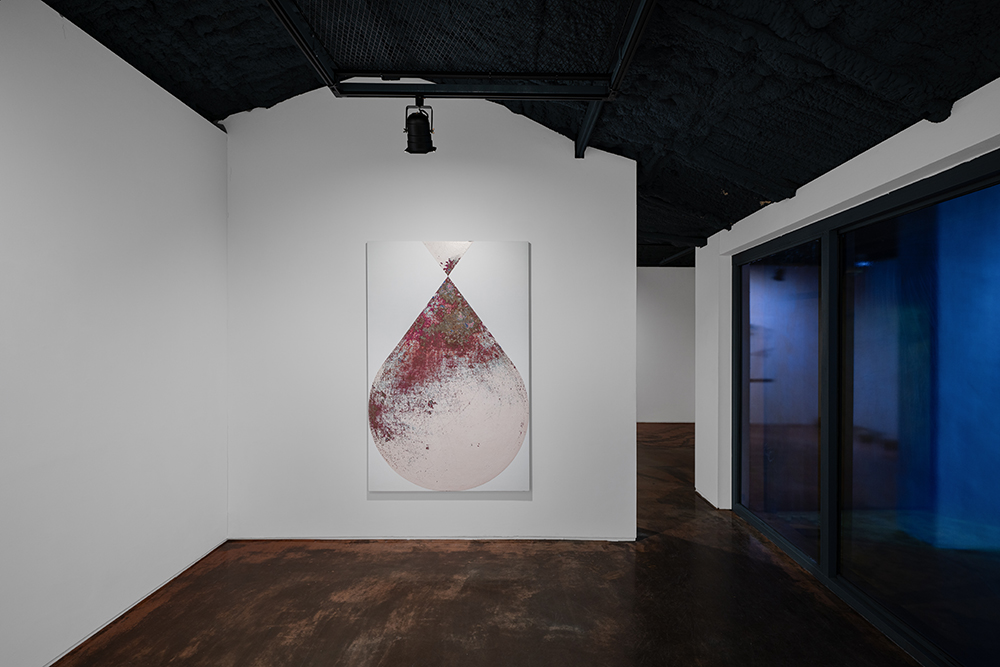
설치전경
From Image to Substance: Thoughts on Eunkyung Lee’s Meta-Paintings
While seeking to comprehend internalities of objects in their unfolding, you remain content in observing their externalities. You cling to the shell while yearning to taste the marrow.
As Maurice Denis famously noted, we should remember that first and foremost, a painting is essentially a flat surface covered with harmoniously arranged colors before perceiving it as a horse in the battlefield, a nude woman, or even an anecdote. As history demonstrates, the focus of artistic interpretation has gradually shifted from the “what to paint” to the “how to paint”. The long-standing debate over whether to prioritize representation or non-representation may, in this regard, be understood as perspectival conflict regarding the prioritization of content over form or vice versa, which in turn shows how artists have ardently inquired into the medium with respect to the definition of painting. Whether one favors theme, or compositional elements such as lines, colors, planes, or rhythm, there exists a point that is often and universally overlooked; while a painting may be an anecdote or a plane of color combinations, it is first and foremost a compilation of paint, applied to a foundational surface. Materiality has, of course, been a central concern; for instance, Clement Greenberg advocated an extreme form of materialism, insisting that purity in art means willingly embracing the limitations of each medium and as such the originality of paintings must be attributed to the inviolable planarity of the painted surface, the tangibility of oil paint, and the material of the supporting plane. However, even Greenberg neglected to highlight the material foundations that produce the planarity of abstract color fields of paintings – in other words, the raw materials of paint.
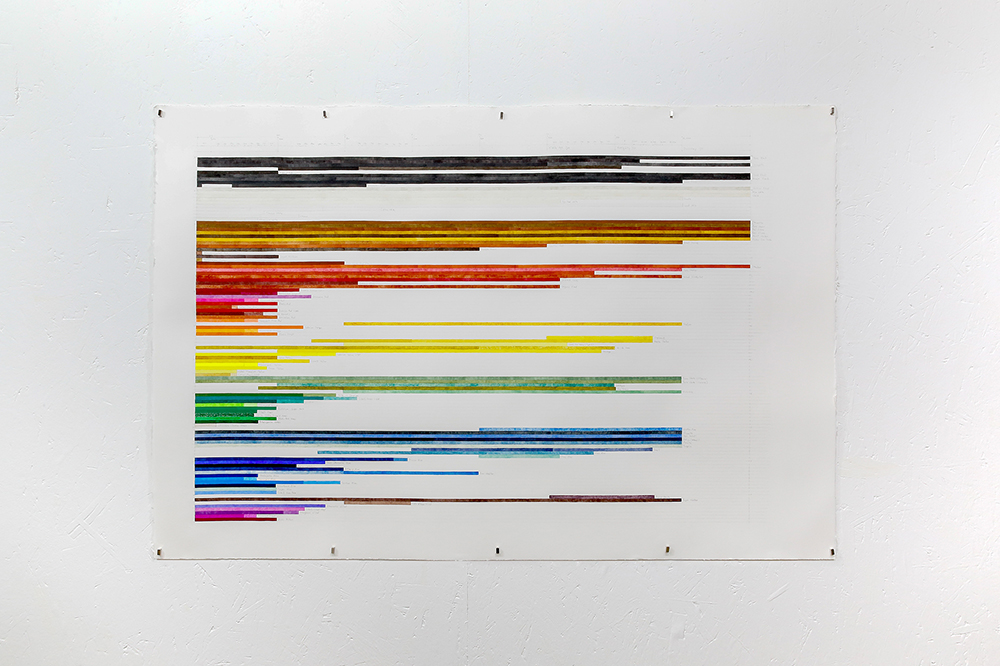
무지개를 풀며 108_Unweaving the rainbow 108, 120x80cm, 종이에 연필, 108가지 안료, 난황, 2019
Tempera as Meta-Painting
Eunkyung Lee’s tempera work, since 2008, is an experiment that reinstates substance as the focal point of media exploration. Substance has always been key to practical production, but its importance has been largely overlooked of late. Her paintings, with their focus on substances that precede the image – or more specifically, substances (pigment and medium) that create the colors, are meta-paintings that return to and explore the most fundamental constituents of paintings. To this end, the artist summons the tempera, which is now seldom used due to its unwieldiness and slow pace, back into the folds of contemporaneity. Tempera painting involves the use of powdered pigments, mixed into egg yolks. Since the yolk is the main medium, the resultant paint is hardly durable, prone to spoiling or degeneration. The range of color availability is also limited due to the lack of demands and difficulty of preservation - as such, one must personally produce necessary paints with pigments in order to generate the kinds of colors in need. Because tempera tends to be unpliable, it can neither be spread out smoothly nor stacked to created thick materiality. Still, due to its superior chromatic impact, far exceeding that of watercolor, tempera endured until oil paint on canvas became mainstream in the 16th century.
Lee may have chosen tempera because "the finished, dried end product's color comes ever-closer to the original pigment’s color, facilitating the prediction of the final hue." Given that her ultimate objective is to experiment with the "pictorial event, generated by colors as a sculptural substance with proper mass and texture," the tempera technique adequately serves her need to ensure maximum proximity to the pigment'schromatic feel.Indeed, my experience that tentatively produces tempera paint at the artist's studio using materials such as lapis lazuli (mineral), cochineal lake (insect), and realgar (mineral) proved that mineral paint retained the texture of the particles, which could be literally felt in the process of mixing and applying the paint, while animal or vegetable-based paint had finer grains that allowed for a more even and deep development of the hues. If the pictorial event Lee aims for is to reveal the comprehensive sense that comes from the substance by "fully absorbing the texture of the grains that get caught at knife or brush-point" while creating and applying the paint, tempera is an optimum material for her type of meta painting.
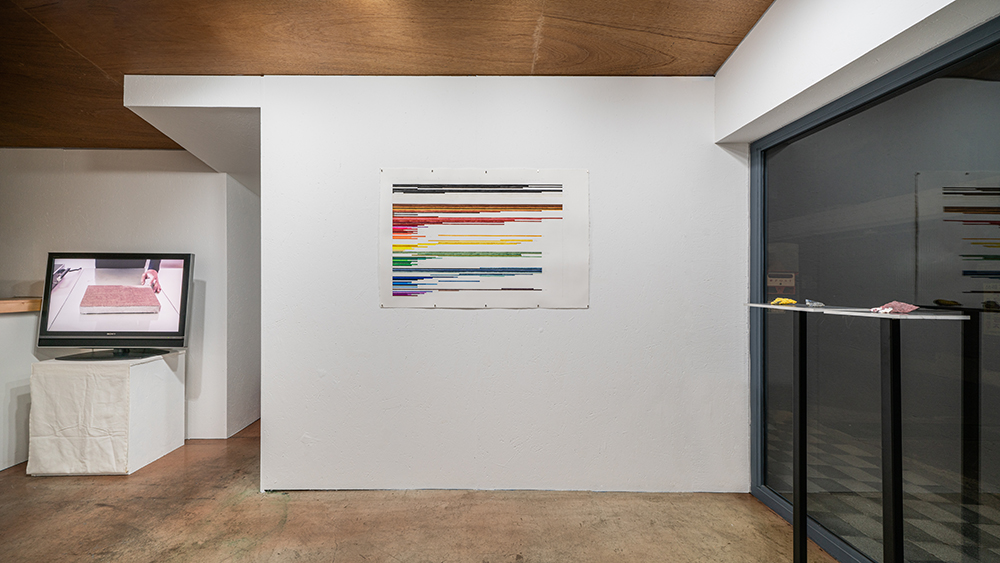
설치전경
Material and Image
As any artist would know, the property of an image or the techniques used to create it are dependent upon the materials. The subjects and techniques applied to draw a fast-drying acrylic painting drastically differ from those suitable for slow-drying oil paintings. In the same vein, the materiality of the substances in Lee's tempera also affect the conceptualization or characteristics of the images. Collected Samples (2010-2011, 2013) series, which precede this exhibition, consist of everyday images collected from fliers, magazines, the streets on to round canvases that resemble sample plates. Since the objects are taken from the surface of actual items such as packaging papers or labels, the images are figurative and the forms are - albeit partially - still discernable. Since then, Lee has been scratching the surfaces of her works by sandpapering the canvas or engaging in performative feats such as pushing the canvas around the floor with participants’ feet. The canvas, cracked and deformed like graffiti or the surface of a skateboard, gestures back to tempera's fragile materiality -inelastic and unendurable, easily succumbing to impact. As another critic had noted, the physical vulnerability of the material ruptures the representative structure, attesting to the fragility of the illusion.
Since then, her work has shifted away from figurative images, focusing more on the surface of paintings and the essence of images. The Matters Considered Out Of Place (2018) series, introduced at the exhibition PHARMAKON (THISWEEKENDROOM, 2018), demonstrates the full extent of a technique wherein layered paint is exposed through sandpapering process. Legible forms and illegible abstractions coexist, with two disparate dimensions (a representative image versus an abstract image that instantiates its own materiality) made of identical materials interface. The process of transition from one dimension to another is also interrelated to artist’s transition from figuration to abstraction.
The six pieces in her Eclipse series, presented at the current exhibition PLACEHOLDER (PLACE MAK, 2020), showcase the current state of Lee's work in full-fledged abstraction. As she uses three to four layers of paint to generate a single hue, stacking up at least thirty colors, each of the pieces comprise scores of tempera color layers. In her later works, Lee scratches out the color layers using different sandpapers of different textures. Sandpapering is an act of reversal, "digging into, or behind surfaces that usually protrude forward or upward." Her work presents the transformation of abstract forms, dependent upon the strength and direction of grinding, the order and method of color stacking, and the area and depth of the scratched surface. For instance, the area and direction of the surface exposed by sandpapering in A Half (2018) converge upon the points of the polygon; the correspondence between form and exposed color planes is a new development that cannot be found in her past productions. This tendency to transform abstract sense into physical form can also be seen in other works. In Basil(2018), wherein she uses the infinity symbol to represent the unwavering vitality of basil plants in the height of summer heat, the area and depth of the exposed paint layers become wider and deeper as they approach the cusp (the concentration point of energy) where the bell shapes interface. Meanwhile, she also conducts experiments in which the same form evolves into different abstract expressions through discrete grinding techniques. Déjà vu (2019) embodies distinction and repetition through identical yet different, and different yet identical forms by grinding out identical forms into different shapes, while A Half, a diptych piece forming a set, capitalizes on the formal characteristics of the canvases (one whole when connected, but discrete objects when separated). Here, she maintains the same paint layers when the canvases are attached, and applies distinctive grinding techniques when they are separated, connecting the formal transition to a qualitative difference in the images with diverging colors and formal expression.
The Eclipse series minimize brush techniques, color or formal conversions that often serve as key factors in oil paintings. In the pieces, the brush is merely a tool for uniformly applying a color plane, and the artist's own interpretation or interference is held at bay. The technique of reserving expression and simply stacking up color planes is the result of embracing tempera's materiality. Drying faster than oil paint and forming a relatively solid layer, tempera paint isnaturally conducive to stacking, facilitating the process of grinding out layers. The transition from tempera to oil paint during the Renaissance period was, in this vein, due to the fact that oil paint was better suited for glazing or impasto techniques, if the coagulation process was properly controlled, allowing for a natural shading effect and texture expression.Oil paint and canvas combined, which respectively helped artists demonstrate their artistry through splendid brushstrokes and ensured the mobility of the resultant product, the history of art clearly shifts its focus from "what one paints with" or even "what one paints" to "how one paints." In this light, the minimization of brushstrokes and the illusion of imagery in the Eclipse series can be understood as an archeological discovery that redirects artistic attention from technique or concept to material and substance.
Substantive Imagination and Intimate Time
Tempera, for which all the paint must be personally produced by the artist, is ultimately an exploration of coloring pigments. Working on tempera over years, Lee studied various natural pigments and organized a chronology of the history, characteristics, raw material, and chemical composition of the varied colors. Pigments for black paint alone range over a wide spectrum of materials, including minerals(soot, volcanic glass), animal(squid ink) and plant-based elements(grape seeds). These colors display subtle yet distinctly unique differences in their hue and texture, which cannot be readily found in other kinds of paint. The black hue of grape seed char displays a bluish tone, while squid ink produces a semi-transparent black hue with a tinge of fishy odor. Gazing upon, touching, and feeling the colors nature offers, Lee contemplates on nature's time and marvels at the infinite potential of the substances: "I reconstruct the present, creating paint with fresh organic materials every day, slowly layering the colors and repeating the process of scratching and grinding them out. By doing so, I incessantly intervein internal and natural times in the form of artistic language, record the phenomena unfolding within myself in the shape of colors, and continue to reflect on their significance."
Lee's words, implying a near-religious degree of self-discipline, is reminiscent of Wolfgang Laib's attitude. Laib's work, wherein he uses purely organic materials such as dandelion pollen, milk, rice, and beeswax, is a ritualistic process from start to finish - from collecting the materials to actual production. The process of harvesting only four to six bottles of pollen after six full months of toil, then sifting this hard-earned yield and spreading them over the gallery floor in thin layers, is a reverent ritual of expressing humility and surrendering himself to nature. Through the pollen, which embodies the artist's prolonged efforts and discipline but also symbolizes the origin of life that fosters the next generation, the viewers are presented with the timeless flow of nature and sense spiritual forces nestled within concrete objects. With her tempera, Lee also experiences the abundant and delicate colors arising from natural materials, drawn into reflections where "natural time and internal phenomena become intertwined." Having accompanied paintings since the beginning of history, the archeological time of pigments intersects with the present time of the artist as she senses the hues of the colors, while the temporality of slow and arduous endurance, through the process of repetitively applying, drying and restacking various color planes, interfaces with the viewers' temporality of presentness as they instantly sense the resultant painting. This nonlinear temporality, whereat past, present, and future are interwoven, is at once Benjamin's dialectic time of creative transcendence and Bergson's time of cosmic duration.
Lee's approach, entering the time of substance to create colors by moving beyond image and form, is none other than Bachlard's substantive imagination in its aspiration to the abyss hidden within the physical images beneath their surface: "working people are not restrained to 'the surface of objects'. He dreams of intimacy - as 'profoundly' as a philosopher. He pours the maximum amount of beeswax wood can absorb, while remaining wary of excess." Strindberg saw the cosmic mystery nestled within the minuteness of objects in a walnut seed, and Francis Jammes discerned what lies beneath the surface through the foaming streams in the Pyrenes. Audiberti, meanwhile, felt the delicate darkness concealed underneath the whiteness of milk. Uniformly, they discovered the most detailed intimacy of substance, delving straight into their core. As the creator of Water (2018), which embodies the unique kinetics of tension that Lee observed in water, Lee also went beyond the surface of objects and penetrated their core, and as such could be seen as a dreamer.
Here, I would like to make a suggestion. Lee's work began with her exploration of pigments and progressed toward abstraction, moving away from instantaneous images and instead diving into pure sensations. Perhaps, by deepening the connection between the intimacies of observed objects as the origin of the abstract images and the intimacies of pigments that visualize them, a new path to yet another field of profound imagination may open up. This because, unlike Armadillo (2019), a three-dimensional piece that generates wind along the patterns of maple seeds attached to a spherical shape, explorations of the pigments and the abstractions in her paintings remain separate, practicing her substantive imagination in disparate manners. Should these be brought together, the intimacy she pursues, with which she reaches out to primal archetypes by drilling all the way down to the core of the substance, will acquire a newfound force. Then, "just as the darkness between the stars rest on the celestial sphere, the night of minerality each of our hearts harbor" may ever deepen.
Hye Jin Mun
|
